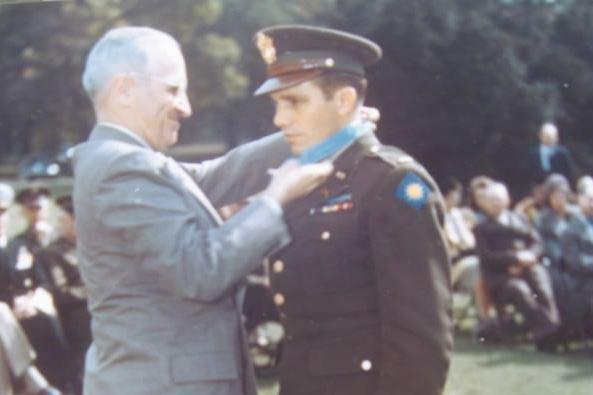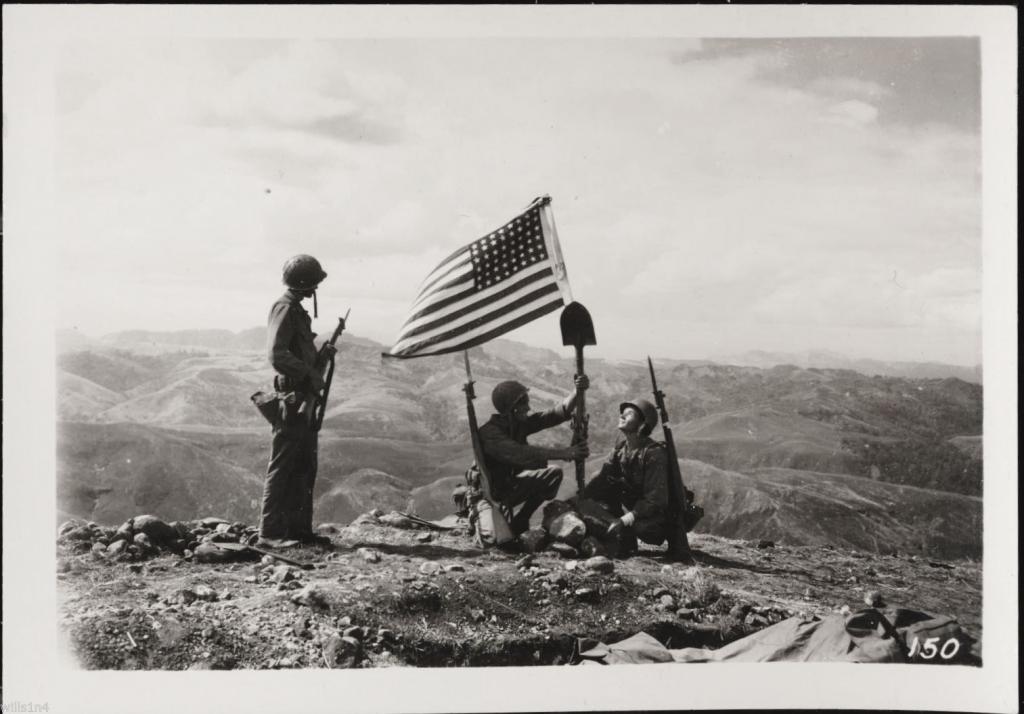After brief stopovers on New Guinea and Manus Island, the 40th Infantry Division landed in the Lingayen area of Luzon at 09:36 hours on 9 January 1945. It was followed up with another landing at Bamban. While opposition during the first landing was light, Bamban was a different story. The division battled the main Japaneseforce in the Bamban Hills, Fort Stotsenburg and Clark Field, The Zambales Mountains, Snake Hill, Storm King Mountain, The Seven Hills, and the mountain known as the Top of the World. In the final phase the battles moved to Scobia Ridge, Hill 1700, and Williams Ridge. On 2 March, the division was relieved by the 43d Infantry Division.
40th Div Philippines Flag raising on hill 1700 by 185th division
World War II
Activated: 3 March 1941 (National Guard Division from California and Utah).
Overseas: 23 August 1942.
Campaigns: Bismarck Archipelago, Southern Philippines, Luzon.
Distinguished Unit Citations: 3.
Awards: MH-1 ; DSC-12 ; DSM-1 ; SS-245; LM-21; SM-30 ; BSM-1,036 ; AM-57.
Commanders: Maj. Gen. Walter P. Story (March-September 1941), Maj. Gen. Ernest J. Dawley (September 1941-April 1942), Maj. Gen. Rapp Brush (April 1942-July 1945), Brig. Gen. Donald J. Myers (July 1945 to inactivation).
Returned to U. S.: 7 April 1946.
Inactivated: 7 April 1946 (See National Guard).
Sjogren, John C.
Rank and organization:Staff Sergeant,Company I, 160th Infantry Regiment, 40th Infantry Division
Place and date:Near San Jose Hacienda, Negros, Philippine Islands, May 23, 1945
Entered service at:Rockford, Michigan
Citation:
He led an attack against a high precipitous ridge defended by a company of enemy riflemen, who were entrenched in spider holes and supported by well-sealed pillboxes housing automatic weapons with interlocking bands of fire. The terrain was such that only 1 squad could advance at one time; and from a knoll atop a ridge a pillbox covered the only approach with automatic fire. Against this enemy stronghold, S/Sgt. Sjogren led the first squad to open the assault. Deploying his men, he moved forward and was hurling grenades when he saw that his next in command, at the opposite flank, was gravely wounded. Without hesitation he crossed 20 yards of exposed terrain in the face of enemy fire and exploding dynamite charges, moved the man to cover and administered first aid. He then worked his way forward and, advancing directly into the enemy fire, killed 8 Japanese in spider holes guarding the approach to the pillbox. Crawling to within a few feet of the pillbox while his men concentrated their bullets on the fire port, he began dropping grenades through the narrow firing slit. The enemy immediately threw 2 or 3 of these unexploded grenades out, and fragments from one wounded him in the hand and back. However, by hurling grenades through the embrasure faster than the enemy could return them, he succeeded in destroying the occupants. Despite his wounds, he directed his squad to follow him in a systematic attack on the remaining positions, which he eliminated in like manner, taking tremendous risks, overcoming bitter resistance, and never hesitating in his relentless advance. To silence one of the pillboxes, he wrenched a light machinegun out through the embrasure as it was firing before blowing up the occupants with handgrenades. During this action, S/Sgt. Sjogren, by his heroic bravery, aggressiveness, and skill as a soldier, single-handedly killed 43 enemy soldiers and destroyed 9 pillboxes, thereby paving the way for his company's successful advance. For his heroic act in the war the city of Rockford, Michigan had a day for him. They called it Sjogren day on the date of September 14. After serving the two wars he came home to live in peace. John lost his life to cancer.
 Information
Information

Warning: This is a relatively older thread
This discussion is older than 360 days. Some information contained in it may no longer be current.
- Knowledge Library

- MKL Entry of the Month
- Australia
- Austro-Hungarian Empire
- Canada
- Czechoslovakia
- Denmark
- Finland
- France/Belgium
- Germany
- Italy
- Japan
- Norway
- Russia
- South America
- Sweden
- Switzerland
- Turkey
- United Kingdom
- United States
- Yugoslavia
- Is my rifle authentic or a fake?
- Jay Currah's Lee Enfield Web Site
- On-line Service Records (Canada)
- Technical Articles/Research
- Forum
- Classifieds

- What's New?
-
Photo Gallery

- Photo Gallery Options
- Photo Gallery Home
- Search Photo Gallery List
-
Photo Gallery Search
- Video Club

- iTrader












 PM
PM



